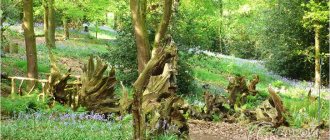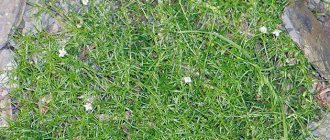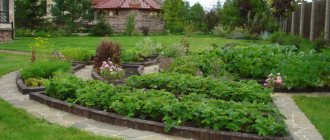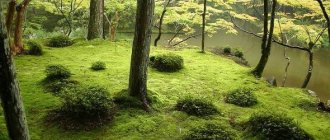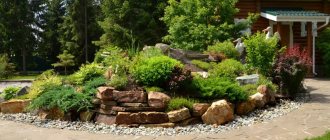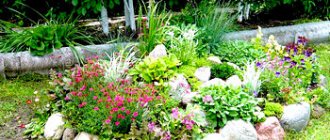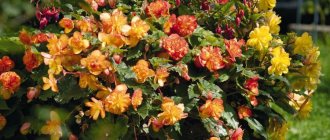Many owners of private houses create an alpine slide on their property to decorate their garden space. She is beautiful, always interesting, unusual. However, the Czech rolling pin, which has won the name “rock garden of the 21st century,” looks much more unusual. A relatively new type of rock gardens in landscape design, suggested to Czech masters by nature itself, is rapidly gaining popularity around the world. Visually, this design seems very complicated, but creating a Czech rolling pin with your own hands is quite easy. You will be convinced of this after reading the article.
How to make an alpine slide with your own hands
To create a simple composition on a site, you need to perform steps step by step.
Selecting a location
When choosing a location for a rock garden, you need to consider some factors:
- exposure to sunlight on the composition;
- the southern slope is not suitable for creating a slide, as it can be very hot there;
- The rock garden should be clearly visible from all sides of the site.
Another important aspect to take into account is proper drainage installation
Site preparation (drainage)
Plants will not grow well if the soil in the selected area has not been prepared in advance. If drainage is poor, the slide is likely to sag. Therefore the following procedure should be followed:
- dig a hole 70 cm deep with a diameter of 2 m;
- pour crushed stone or sand onto the bottom of the pit;
- then cover with a layer of soil;
- compact.
Installation of stones
It is recommended to place stones on the hill taking into account your own taste and imagination. The following features should be taken into account:
- You should not install large stones on a small alpine slide, as this looks unsightly and can lead to sagging of the slide;
- Large stones are laid down, and small stones are placed on top;
- It is best to choose boulders of one type;
- Do not stack stones tightly to each other;
- It is recommended to make at least 3 tiers of stone.
Watch the video! How to build an alpine slide
Selection of plants for an alpine hill, features of their planting
In order for the rock garden to delight with continuous flowering, it is necessary to carefully select plants for the alpine slide. Plants should be planted in layers.
You can use the following flowers for an alpine slide:
- Hellebore (Helleborus) – blooms in early spring with white, pink and blue flowers. It is recommended to grow the plant in a shady area. Watering hellebores should be limited.
- Krupka (Draba) - blooms until May 15, decorates the area with orange and yellow flowers. The plant requires moderate watering and sunlight.
- Bergenia (Bergenia) - beginning of flowering - beginning of spring, pink flowers, requires moderate watering and partial shade.
- Aquilegia, columbine (Aquilegia) - flowers of various shades appear in May, the plant needs abundant watering and shade.
- Small-bulbous - the first flowers of various shades appear in the spring; the variety requires partial shade and moderate watering.
- Primrose (Primula) - begins to bloom before May 15, the flowers have a variety of colors, the plant requires moderate watering and location on the sunny side.
- Arabis, Arabis - flowers of white, red and pink shades appear in spring; the variety requires shade and abundant watering.
- Anemone - blooms from May with pink, white and yellow flowers, moderate watering and a sunny location are recommended.
- Navelwort (Omphalodes) - blue flowers appear before May 15, needs moderate watering and shading.
- White Brunnera (lat. Brunnera) - the plant blooms before May 15 with bluish flowers; moderate watering and a shaded location are required.
- Creeping Tenacious (Herba Ajugae) – blue flowers appear in June, the plant requires moderate watering and a sunny position.
- Irises (Iris) - blooms in June, blue flowers, requires light watering and location in a sunny area.
- Gravilat (Geum) - pink flowers appear in June, moderate watering and partial shade are recommended.
- Carnation (Dianthus) - needs to be grown in a well-lit area with minimal watering; the flowers appear in summer and have white, red and pink shades.
- Periwinkle (Vinca) – Pink, white and blue flowers appear in June and require minimal watering and partial shade.
- Hoofweed (Asarum) – needs plenty of water and shade, pink flowers appear in spring.
- Alpine aster (Asteralpinus) - lilac-blue flowers appear in June, moderate watering and growing in a sunny area is recommended.
- Phlox subulata - crimson flowers appear in June, the plant needs moderate watering and a sunny place.
Flowers should be planted in several tiers. At the same time, do not forget about the right combination of flowers, bushes and trees.
Watch the video! We create an alpine slide with our own hands
What to build from?
Even a small alpine slide built with your own hands is a design project, albeit small, but one that requires attention, and therefore requires the construction of a construction diagram.
You can sketch out such a diagram yourself, and in it indicate the materials necessary for planting, the location of large boulders, and select the flowers and plants that will grow on it.
The classic list of materials for a slide is:
- Suitable stone and pebbles
- Sand (coarse is better)
- "Greenery" (in the form of flowers and mini-trees)
- Sphagnum moss
“Czech rolling pin”: what kind of animal?
What is a Czech rolling pin? A rock garden in the form of a cracked stone hill, which came to us from the Czech Republic, is formed using rock plates installed edge-on into the ground at a short distance from each other, with the ends of the stone forming a wavy plane. Alpine plant species and dwarf trees are planted in narrow crevices formed between stone plates and covered with substrate and fine gravel on top so that not an iota of the ground is visible. The strangeness of this approach to creating a rocky garden leads to a completely unusual result - it seems that greenery and flowers are breaking through directly from the thickness of the rocks.
The main feature of the “Czech rolling pin” rock garden is maximum naturalness, which is achieved by simulating the principle of the structure of the Czech mountain ranges
To form a Czech rolling pin, stone slabs are installed almost vertically, at an angle of 10-15 degrees relative to the plane perpendicular to the ground
Due to the thin crevices formed between the slabs when forming a Czech rolling pin, it seems that the plants planted in them grow directly from the stone
Why is the Czech rolling pin so good that gardeners from all countries have unanimously switched from building traditional rock gardens to a layered stone slide?
Here are several reasons for this phenomenon:
- Naturalness. The Czech rolling pin almost completely imitates a natural rock formation, introducing a piece of untouched nature in its pristine beauty into the landscape design.
- Balance. Due to the existence of narrow long gaps between the stone slabs, an optimal microclimate is created for the growth of alpine plant species - with moderate humidity and temperature.
- Unpretentiousness. Small distances between the stone plates contribute to the retention of moisture in the soil, because the plane of evaporation is negligible - accordingly, such a hill does not require watering or additional drainage, and there is too little space for the development of weeds in the crevices of the Czech rock garden.
The steep Prahov cliffs and rock outcrops, characteristic of the forest areas of the Czech Republic, inspired Czech gardeners to create the “Czech rolling pin” rock garden.
To create an alpine slide with a Czech rolling pin, you need to select a layered stone and install it almost vertically
Alpine plants for the Czech rolling pin are planted in the crevices formed when installing stone slabs
Canons of a layered Czech rolling pin:
- The entire Czech hill must be made of one rock in the form of flat slabs of varying thickness, or of more rounded stones, but necessarily having 2 flat edges.
- When creating a Czech rolling pin, slabs of stone must be installed so that narrow and long vertical crevices with a thickness of about 2-5 cm are formed. Thus, the alpine slide will be as close as possible to the natural rock formations characteristic of the Czech mountain ranges.
- Stone slabs for the Czech rolling pin are selected in irregular shapes and buried in the ground in order to create longitudinal and transverse waves, the peaks of which are then emphasized by plants designed to further enhance the dynamics of the miniature mountain range. The Czech rolling pin should have several peaks to create the complete illusion of mountainous terrain.
- The soil cover between the stones formed into a rock garden should be completely invisible, for which all areas of the ground are covered with crushed stone of various fractions.
The stone for the rocky garden “Czech rolling pin” is selected in the form of slabs of various thicknesses
When forming a Czech alpine hill, stone slabs are laid both vertically and horizontally
The Czech rolling pin rock garden will be an excellent decoration for a concrete border
We are sure that you are already interested in how to make an alpine slide using the “Czech rolling pin” method, but you don’t know where to start, what types of stone and types of plants to choose for such an original rock garden. We offer you information, as they say, first-hand - it will help you set up a Czech rolling pin in your dacha with minimal effort.
Larger plants are planted on the tops of the Czech rolling pin, emphasizing the dynamics of the height difference
By folding a rock garden “Czech rolling pin”, you can get a fairly strong fence or retaining wall
For horizontal masonry of a Czech rock garden, select stone slabs of different thicknesses
Choosing stone and plants for a Czech slide
Based on the fact that the Czech rolling pin has a not quite traditional appearance for a rock garden due to vertically installed stone slabs of different thicknesses, only layered sedimentary rocks - limestone, sandstone, slate - are suitable for it. These types of stone are good because over time, the sharp corners of these relatively soft rocks are smoothed out and the outlines of the slabs acquire a more natural appearance. Among other things, the light ocher or grayish color scheme of the stone of sedimentary origin is pleasant to the eye.
When purchasing stone, it is advisable to immediately estimate how many tons of rock will be used to create your mini mountain range. It is not advisable to purchase additional stone, since slabs from different batches will differ in color, and this is an extremely negative point for the Czech layered slide.
It is important to know! In order to roughly calculate the volume of stone required, we present the consumption of materials when constructing a Czech rolling pin with an area of 20 square meters: limestone - 4 tons, rubble stone (for the base of the peaks) - 1 ton, gravel (for backfilling) - 0.5 tons.
The Czech rolling pin rock garden is formed from layered stone of sedimentary origin - slate, sandstone, limestone
Plants for the alpine slide Czech rolling pin are selected in accordance with its dimensions and to enliven the stone surface - miniature and bright
To plant a Czech rolling pin on a rocky hill, it is best to choose miniature, colorfully flowering alpines
Regarding the selection of plants for the Czech rolling pin, there are no special differences compared to a traditional rock garden. As before, the green alpines and dwarf trees should be comparable to the rocker in size and growth rate. Daphnes, bluebells, gerbils, dredges - the list of miniature alpines suitable for landing on a Czech rolling pin can be continued endlessly. The indigenous inhabitants of the Alpine mountains can coexist perfectly with forest and steppe species of flora - ferns, bulbous, dwarf conifers. For planting on the tops of the Czech rolling pin, phlox, krupka, and aubrieta are ideal, and for the slopes - ground cover arabis, tenacious, yaskolka, young, sedum and sedum. Crocuses and muscari will look good at the foot of a rocky alpine hill.
Article on the topic: Selection of plants for an alpine hill: examples of varieties + decor rules
Recent Entries
Lilac perennials that are beautiful, compact and do not crowd out other plants Why when buying seedlings you should not take the sellers’ word for it and how to determine the age of the plant using 3 signs Tomato seedlings have turned purple or whitish: why the color has changed and how to save the plants
Where to build?
A shady place is not suitable for a rock garden. It may be in partial shade, or a light shadow may fall on some part of it, but it should not fall completely into dense shadow. The place should be sunny and warm. It will be very good if there is an elevated relief on the site: in such a place the rock garden will look most natural, but this is not important.
If it is planned to make a pond on the site, then it is usually combined with a rock garden. The soil removed from the pit is used in the construction of the embankment. Sometimes equipment that is necessary for constructing a waterfall or fountain is hidden in a rock garden. When creating such a composition, the pond is decorated in the same style as an alpine slide.
Miniature slide
A miniature alpine slide will require very little space and materials. Its construction does not require heavy earthworks. At the same time, you can get no less pleasure from creativity than when creating a large landscape object.
A small rock garden can be created even in an ordinary ceramic bowl.
And only you can decide in what style, from what materials, what size your mini-rock garden will be, where it will be located, what plants will settle in it.
A miniature slide will require very little space and materials
This idea is right for you if:
- You don’t have much space on your property, but you want to make a rock garden;
- you doubt your decision and want to “try it first”;
- you do not have the opportunity (technical, financial, etc.) to arrange a large rock garden;
- you need to effectively display a small collection of succulents;
- you just love miniatures.
By the way, popular tabletop Zen gardens - Japanese rock gardens for home meditation or simply calming the nerves - are essentially the same miniature rock gardens. Plants are usually not used in them - only stones and sand. And if only a few can afford to build such a place in their dacha “life-size”, then there are no restrictions for the mini version.
Not everyone can create a Japanese rock garden in their country house, but its miniature version is available to everyone
In the garden, miniature slides look great placed in massive concrete containers (more precisely, in containers made of hypertufa - lightweight concrete made with the addition of peat, perlite or vermiculite). They can be used individually, or you can make various compositions out of them.
Massive concrete containers are a suitable basis for future compositions
However, if you like other container options, there are no restrictions. But what is worth thinking about is the wintering of the inhabitants of miniature man-made landscapes. Raised containers with a small volume of soil freeze during the cold season, and this is often fatal for plants.
It’s worth thinking in advance about how the inhabitants of your miniature hill will spend the winter.
It’s unlikely that anyone will like the idea of dragging a heavy concrete bowl filled with stones into the basement, so it’s better to find frost protection options for such compositions in advance.
And plants for any rock garden can be selected in our catalog, which presents products from large online stores of planting material and seeds. View the selection and choose plants for your rock garden.
Alyssum Vanilla Cloud 13 RUR Russian Vegetable Garden Jaskolka Snow Carpet 16 RUR Russian Vegetable Garden Edelweiss Alpine 16 RUR Russian Vegetable Garden Thyme Purple Carpet 13 RUR Russian Vegetable Garden
Alpine slide with bridge
A rock garden with a bridge is a functional decoration in the yard. It is very convenient if the decor with a pond is placed on a large area, on which there is a temporary shelter, gazebo or other buildings on both sides. You can construct a slide as follows:
- We prepare the place and make drainage.
- Then we pour the required amount of soil, after which we create multi-level terraces from stones of the same structure.
- We leave space for future flower beds.
- Then, starting from the slope, we lay large pebbles.
- We make a trench of the required length, up to 40 cm deep, and line it with sea stones.
- To ensure they stick well, it is better to place them on cement mortar.
- On both sides of the pond, we lay paving slabs perpendicularly.
- After the path has frozen, we install a bridge over the pond so that it overlooks the path.
Placement of decorative elementsSource zen.yandex.com
- The bridge can be made of a metal frame with fixed boards. But it’s easier to buy it to order.
- We drill two holes in the sidewalk on each side and drive stakes into them.
- Then we weld the bridge to them so that it holds securely.
Bridge over a dry streamSource samstroy.com
Lilies near the rock garden are a good choice Source lanshaft.com
The main stages of the construction of the Czech rolling pin
The process of creating a stone composition can be divided into several steps, described below.
Preparing the selected site
The selected area must be cleared of debris, tall plants, and grass. If necessary, you can go deeper into the ground, but this is rarely done. In the designated cleaned area, pour sand and form a small “pillow”.
Installation of stones on the future composition
Stones sorted by size are installed on the edge at a slope of 5-10 degrees.
Initially, large stones are installed, then an imitation of a mountain range is created from smaller planes. The distance between the stones should be no more than 15 cm. Small stones, pieces of brick, and pebbles can be used to support stone slabs
Filling the space between the stones
The crevices between the installed stones are filled two-thirds with sand (fine crushed stone can be used). After filling the voids between the stones, the area is carefully moistened. This is necessary for the natural shrinkage of the stones. When watering, try not to wash away the sand.
The structure should be left in this state for a couple of days. During this time, a natural shift of the plates will occur, the stones will find their place in the structure and the sand will settle tightly. The remaining space in the crevices is filled with soil. It needs to be lightly compacted and moistened. The composition of the soil is selected according to the preferences of the plants that you will plant on the hill.
Planting plants in the Czech rolling pin
It is better to choose plants for this composition that feel comfortable in mountainous areas, can withstand drought, are unpretentious to the soil, and are easy to care for.
Plantings of this type of rockery should not be abundant.
Dwarf coniferous crops and small flowering bushes will look good. Even if the plants are not flowering, they should have a decorative appearance all season long. There is no need to choose fast-growing plants; they require additional care and replanting; abundant greenery will distract attention from the hill itself.
The main beauty of the stone hill is the stone slope; the plants only complement it.
Final stage
We cover the areas with soil with fine crumbs or gravel (wood mulch is suitable). After all the work has been done, the rolling pin needs to be moistened with a garden hose. This will remove residual soil from the surface of the stones and nourish the plants with moisture.
The final stage of creating a Czech roller coaster
At the final stage, a DIY Czech rolling pin should look like a real mountain, created by nature, winds, and other natural phenomena, the space of which was eventually decorated with plantings of mountain flora.
If you still want to make a small pond near a mountain slope, you can create a small grotto at the foot of a rocky composition, fortified with boulders. This will of course require a lot of effort to construct, but the result will be impressive.
As you can see, a Czech rolling pin can be created with your own hands without any extra effort, and the created beauty will pay for the effort many times over. We hope that the article will be useful and will inspire you to experiment in landscaping your garden area.
Source
DIY Alpine slide - selection of plants
The construction of an alpine hill, especially the selection of plants, requires additional knowledge about plant varieties and agricultural technology. Plants are selected depending on the type of hill. A rocky hill for sunny locations requires specific, drought-tolerant plants. The classic version of a rock garden involves planting miniature trees and shrubs, perennial herbs and flower crops.
Example No. 1. Decorating an alpine slide with plants
The following have proven themselves to be excellent when planted in rockeries: fescue, lavender, rock alyssum, geranium, sedum, Iberis, young, lumbago. Small-bulbous plants planted in small groups feel great on rocky hills: crocuses, scylla, miniature hyacinths, low-growing tulips and hazel grouse. Small-bulbous plants bloom in the spring, when few plants are still blooming and the hill looks unpresentable. Everything changes when bright, blooming crocuses appear from under the snow.
Example No. 2. Plants for alpine hills
To create a highly decorative hill, it is necessary to provide for the planting of perennial plants that have different flowering periods. Then the slide will look unusual and decorative throughout the entire period. The riot of colors of flowering plants will delight the eye from spring to autumn.
It is especially important to consider the height of the plants used when planting in rockeries. Too tall specimens should not inhibit low-growing varieties, thereby affecting their full development
Bright plants should be placed in the foreground, in the viewing area.
The basis of the composition are miniature trees, especially conifers: spruce, juniper, cypress, pine. These plants have different crown shapes and look great on an alpine hill.
Decorative flowering shrubs used for arranging an alpine hill: rhododendrons, Erica, blueberries and lingonberries.
Perennial crops perfectly complement the alpine hill: bergenia, astilbe, daylily (low-growing), drooping reed.
Alpine hill surrounded by lawn Tip: when forming a rock garden, preference should be given to decorative deciduous plants that retain their beauty even in the absence of flowers.
Creating a Czech rolling pin on the site: an original garden update
Many owners of private houses create an alpine slide on their property to decorate their garden space. She is beautiful, always interesting, unusual. However, the Czech rolling pin, which has won the name “rock garden of the 21st century,” looks much more unusual. A relatively new type of rock gardens in landscape design, suggested to Czech masters by nature itself, is rapidly gaining popularity around the world. Visually, this design seems very complicated, but creating a Czech rolling pin with your own hands is quite easy. You will be convinced of this after reading the article.
Alpine slide with pond
A pit is dug for the pond and the walls are insulated with butyl rubber film. A small pond can be made from a car tire or a special fiberglass liner, which is placed in a pit that follows the shape of the sides. For a stream flowing along a stone bed, a pump is installed in the pond and connected to a water supply hose. For the cascade, take flat stones, fasten them with polyurethane foam, and cover the seams with small fragments.
Saxifraga oppositeifolia is a ground cover plant that is excellent for decorating rock gardens.
A small fountain will decorate the rock garden and create coolness. To make work easier, buy a pump with a built-in filter. The unit is installed in a container, filled with water, and turned on according to the instructions. To create a fountain without a pump, a water pipe is led into a pond. Water can be diverted to the garden for irrigation.
Cottage decoration: (read more)
Choosing a location
When choosing a place to create a rock garden on your plot of land, you need to take into account that you are creating an accent designed to decorate your garden, therefore, it is necessary to place the alpine slide in an open space so that it is an area with a good view from all sides. As a rule, an alpine slide is laid out in the center or on the edge of a grass lawn. It is best to orient the rock garden to the south or southwest - this way it will be well lit by the sun and receive a sufficient amount of heat.
An alpine slide in the center of a green lawn will become a dominant element in the landscape design of your site
The terraced alpine slide will harmoniously fit into the natural topography of the garden
When laying an alpine slide, it is necessary to avoid places adjacent to buildings and in the shade of massive trees, however, shrubs or trees may be present in the background, at some distance, to create a backdrop for the spectacular perception of the rock garden. It’s not bad when the rock garden is integrated into the existing landscape of the land, located on a gentle slope or in a ravine, fitting into the natural differences in elevation - lowlands and hills of the site.
Strive to ensure that the trees and shrubs in the background of the rock garden are uniform in color. A colorful background will distract from the integral perception of the alpine hill as an accent element of the landscape of the site.
The staircase leading up the slope can be beautifully complemented by an alpine slide that imitates a rocky landscape
The starting point for creating a rocky slide can be a diagram of a rock garden, drawn to scale, where you will first plan the placement of stones and planting. If the rock garden is supposed to be placed in the depths of the garden, you need to think through the paths and paths leading to it.
A bench, lost in the depths of the garden, surrounded by a wild corner of nature originally from the Alps, can be a wonderful place for a secluded relaxation
It looks spectacular when an alpine hill is crossed by a rocky winding path or a dry stream of small stones, and nearby there is a bench or grotto with a bench, from where you can admire the result of your landscape creativity.
The rock garden looks great in tandem with a small lake overgrown with reeds and water lilies
A rock garden with a pond looks very harmonious, especially if it is a slightly swampy body of water with characteristic moisture-loving plants planted along the shore. An interesting solution for designing a pond would be to plant a large tree or coniferous bush on a tiny “patch” of land adjacent to the water. This technique will visually expand the boundaries of the site.
A rock garden created from huge stone blocks in combination with a small waterfall will truly decorate your garden
An effective accent of an alpine slide combined with a pond can be a small waterfall falling from an artificial gorge or a stone wall.
Plants for alpine hills: planting rules, names and photos
To obtain a decorative effect, it is not only and not so much flowering plants that are more important, but those that have beautiful and lush foliage, which retains its decorative effect throughout the entire period: from spring to late autumn.
Planting shrubs and trees must be approached very carefully: they still grow to a decent height, attempts to trim them only harm their appearance. Look for dwarf varieties if you like, but check their height. We can recommend horizontal junipers - they grow to the sides, but hardly grow upward. You can use mountain pine or nesting spruce. But this is at a sufficient height of the relief. In any case, trees and shrubs are planted in a “lowland”, and so that it does not block the view.
Example of planting trees and bushes
Plants are planted in groups, but so that between them there is a solid free space filled with stones or small chips. A solid carpet is not for a rock garden. Here each plant is a soloist and each should have a separate stage. Therefore, in the foreground are the shortest, behind them are of medium height, and the tallest are in the background.
Ahead are the shortest
Some plants that are often planted in rock gardens at the dacha or near the house are presented with photos in the photo gallery. Please note that there are mainly one or two varieties depicted, but there may be more than a dozen of them (this is usually the case).
Perennial plants for rock garden
Achillea | Achillea | Ajuga | Anemone | Anthericum |
| Aubrieta | Bergenia | Cerastium | Chiasthophillum | Dianthus |
Dianthus | Dicentra | Erigeron | Euphorbia | Gentiana |
| Geranium | Helianthemum | Hypericum | Potentilla | Nepeta |
| Primula | Prunella | Pulsatilla | Sedum | Sedum |
Sedum | Thymus | Verbascum | Veronica | Veronica |
| Viola | Vinca herbacea | Viola cornuta | Alyssum saxsatile | Achillea tomentosa |
Viscaria vulgaris Splendens | Centaurea montana | Draba aizoides | Dracocephalum ruyschianum | Eryngium amethystinum |
Geum chiloense | Lavandula angustifolia | Lavandula angustifolia | Lysimachia nummularia | Malva moschata |
Meum athamanticum | Oenothera missouriensis | Penstemon barbatus | Phlox divaricata | Phlox subulata |
| Phlox subulata | Potentilla nepalensis | Primula cortusiana | Saxifraga rotundifolia | Sedum reflexum |
How to make an alpine slide
Before creating a rock garden with your own hands, you should carefully study the already designed diagrams and photos of buildings. Principles of organizing a rock garden:
- Select an acceptable site.
- Think over the principle of constructing a reservoir.
- Choose plants and rocks.
- Come up with a design scheme.
- The result of the work must correspond to the intended plan.
An example of a drawing diagram of a rock garden
Place
The first step in creating a rock garden is choosing a suitable location. To comply with all the rules of landscape design, consider the main factors:
- Illumination. This parameter should be moderate, because the water will turn green over time if the sun constantly shines on it. Too much shade will harm the plants.
- Presence of trees nearby. A spectacular alpine slide with a waterfall under the trees is not the best solution. Leaves, branches and possible insects will clog the drain, causing it to need constant cleaning.
- Relief of the site. If your dacha has a hilly area, then it will make a good rock garden. Otherwise, the embankment will have to be made manually, and a hole will have to be dug for the pond.
- Priming. Sandy soil is suitable for a rock garden.
Stones for an alpine slide
Rocks for rock garden
To build a rock garden with your own hands, follow the following recommendations for choosing stones:
Choose stones of different sizes: blocks, boulders, gravel, crushed stone. At the same time, remember about the general dimensions of the slide, the pond, the chosen style of composition and the rest of the landscape area. Choose stones that have different shapes and geometries
Do not try to find identical boulders, as this will not achieve a natural look. When choosing a rock to create a rock garden, pay attention to limestone, granite, and sandstone. To decorate a pond, give preference to more durable rocks that are resistant to washing out, for example, granite, marble, gneiss, quartzite. The scattering of small stones along the bottom of the reservoir and the coast looks beautiful.
Plants
To plant on an alpine hill, choose plants that meet the following parameters:
- low-growing, woody varieties;
- thermophilicity;
- ease of care;
- attractive appearance.
Plants from the following groups are often used to arrange a rock garden:
- ground cover;
- carpet;
- rosette;
- tuberous;
- bulbous.
Planting scheme for an alpine hill
Be sure to pay attention to the time of growth and flowering. For a beautiful appearance of an alpine hill, correctly combine perennial plants and annuals
The following types are excellent for forming a rock garden:
- daisy;
- white flower;
- St. John's wort;
- veronica;
- deer tongue;
- tenacious;
- sedum;
- thyme;
- yarrow;
- alpine strawberries;
- young;
- orostachis;
- lumbago;
- Levisia;
- cuff;
- crocus;
- galanthus;
- Iberis;
- edelweiss;
- phlox subulate;
- iris;
- sleep-grass;
- cultural obrieta;
- alpine carnation;
- Schmidt's wormwood;
- juniper;
- conifers for alpine hills
- saxifrage.
Perfect for decorating a pond:
- lilies;
- water hyacinths;
- swamp rice;
- host;
- delphinium.
What are there
Since alpine slides copy real mountains, they can differ greatly in shape, quantity, size and type of stones, the way they are laid, and also in relief. For example, there are layered stone slides, which are also called “Czech rolling pins.” They differ in the vertical arrangement of layered rocks.
The Czech rolling pin is a striking example of a layered alpine slide
Rocky slides are the most common type of rock garden in our area. This is a small earthen mound on which stones are laid out. The stones are layered or boulders, the space between them is filled with crushed stone, pellets, pebbles or smaller boulders. This will be a rocky hill.
Rocky slide - easy to do with your own hands
But there are those in which the fertile layer occupies a significant area. In this case, single stone blocks stick out from the greenery of the lawn, flowers and small coniferous plants stand out as bright spots. Such plantings imitate alpine lawns.
There are alpine hills with a large proportion of fertile soil
There are alpine ravines. If the site has a similar topography, you can equip it by making an artificial stream. To do this, line the bottom and edges with stones, make a small pond below, from which water is pumped to the top of your “cliff.”
Scheme of an alpine slide with a waterfall and a pond and a waterfall
Plant moisture-loving plants along the banks of the stream and pond, and suitable alpine herbs, flowers and perennials on the rocks. Such a structure is, of course, more technically complex; it also requires more costs - a pond, a stream, a slide - everything requires investment. Such complex systems are already considered landscape slides, since they partially change the appearance of the entire site.
And another type of rock gardens is terraces. Dividing the site into terraces is necessary if it is located on a slope. Then a multi-level device is the best solution. Retaining walls are laid to level the ground. They are often made of reinforced concrete and then decorated with boulders. Ground cover plants also thrive on these retaining walls.
Retaining walls can also be decorated with plants
The same principle - the organization of terraces - is used on flat areas, but with a different purpose: to make it more picturesque. In this case, the height difference is created artificially, and this means a large amount of land work.
Excavation
In order for flowers to grow on the slope of a hill, you must first form a mound of soil. Then cover it with stones so as to leave some space here and there for planting seedlings or sowing flower seeds.
Stages:
- Mark the soil for making the base.
- Dig a shallow hole - up to 1 m deep.
- A fine-mesh mesh is placed at the bottom of the pit.
- Sand (10-15 cm) is poured onto the mesh, a “cushion” of gravel, crushed stone, construction waste, broken bricks is laid, and a 10 cm layer of sand is poured.
- Water everything with water and compact it well.
- Prepare suitable soil (if natural soil is not suitable). Peat is added to fertile chernozem in a ratio of 5:1, and a little peat is added to loamy soil in a ratio of 4:1. Mix both types of peat soils.
- A layer of ready-made fertile soil is poured, forming hills if required.
You can mark the area using pegs and stretched twine. Fine mesh is important as a protective barrier for soil borers. Those who like to dig holes and passages underground will find it difficult to get to the roots of bushes and trees, flower bulbs planted on an alpine hill. The “pillow” is necessary to strengthen the boundaries of the object - its height and shape will remain intact even after long-term heavy rainfall. The central part of the pit should drain in a thicker layer than along the edges.
If there are ponds or streams in the rock garden, waterproofing is requiredSource gid-str.ru
Preparatory work
After the construction site has been determined, you should get rid of bushes and trees in the surrounding area, which in the future may obscure the hill.
If the groundwater level in the area is high, it should be lowered through drainage, as exposure to water can negatively affect the structure over time.
For drainage you will need:
- Dig a pit at the site of the future slide with a diameter slightly wider than the slide itself. The depth of such a pit should reach 80 cm.
- Layer by layer pour crushed stone and small pebbles (about 30 cm) onto the bottom of the pit.
- Add a layer of sand and gravel (about 10 cm more). After each layer, the system must be spilled with water and compacted thoroughly.
- Part of the soil dug at the initial stage is cleared of foreign debris and backfilled. After this, you should give the future slide a couple of weeks to shrink, and then start laying.
What plants are suitable for rock gardens?
The rock garden considers the Alps to be its homeland, therefore the plants must be appropriate and adapted to the alpine growing conditions. There is a planting scheme - shrubs are planted first, herbaceous plants second, and only then ground-blooded representatives. There is no need to change the order. Consider seasonality, so the selection of plants is the main nuance that should be thought through to the smallest detail. Combine decorative ones with evergreens, conifers and flowering plants, then the effect will be more stunning.
The landing principle is as follows. The plant must be planted in a prepared hole, which is formed not only in the hole of the stones. Where the soil was previously compacted, gravel should also be placed at the bottom of the hole. On top of the soil, you also need gravel, so that from the outside it seems that the plants are not growing in the soil, but in it.
Rock garden in the garden: choice of stones, installation options
To make the right choice, you need to know the degree of fragility and porosity of each rock. Sandstone - blocks with a coarse-grained structure are used not only for decorating an alpine hill, but also for planting shrubs with small roots. Granite is used in combination with conifers and heather shrubs.
Alpine stone slide with bright flowers.
Tuff is suitable for high-mountain flora and is beautifully overgrown with lichens. The slate exfoliates into sheets and fits well into a mountain wall or ladder. Dolomite reduces soil acidity and is easy to process.
Plants for rockeries must be selected taking into account their flowering time.
The installation option depends on the type of alpine slide. To recreate the valley, the blocks are placed randomly. For a rocky wall, choose flat fragments of equal height, and compensate for unevenness with small stones. When laying a slide on a slope, the stones are placed parallel with a slight slope back.
Basic rules for placing stones
A lot depends on the location of the stones. Do not pile up stones and plant plants between them. The design should be harmonious. If there is no harmony, then the structure can be considered useless, because the abundance of flowers and stones will make your eyes run wild.
To make the design beautiful, the following rules must be observed: Each type of stone must be the same size. But you should not choose more than 3 types;
There is no specific place where the stones should be placed. It all depends on your imagination. You can make simple patterns or creative inscriptions from stones. Large stones can be placed in the middle or along the edges.
The huge stones that are placed throughout the entire area of the rock garden look very unusual. The hill, which is crowned with a huge granite boulder, looks unusual. You can plant beautiful green plants near it.
